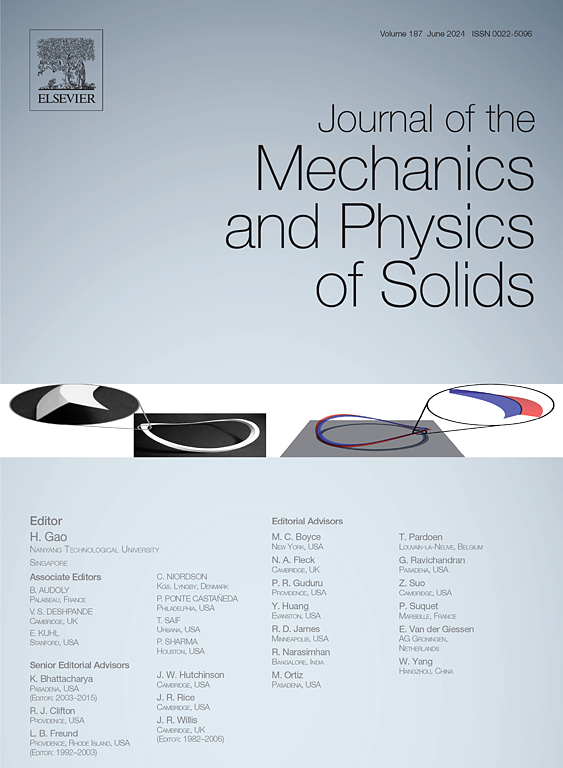一个拓扑优化框架,用于设计一次性识别或发现材料模型的测试样本
IF 5
2区 工程技术
Q2 MATERIALS SCIENCE, MULTIDISCIPLINARY
引用次数: 0
摘要
实验力学中成像技术获得的全场位移数据越来越多,这决定了材料模型校准和发现范式的逐渐转变,从使用几个简单的几何测试到使用几个,甚至一个复杂几何测试。这种“一次性”校准或发现的可行性在很大程度上依赖于测量位移数据的丰富性,即它们探测状态变量空间和应力空间(其中应力依赖于正在寻找的本构律)的能力,其程度足以实现准确和稳健的校准或发现过程。位移数据的丰富性反过来直接取决于试样的几何形状。在本文中,我们提出了一个基于密度的拓扑优化框架,以优化设计目标试件的几何形状,用于各向异性弹性材料模型的校准。为此,我们通过最大限度地提高反问题解决方案的鲁棒性来执行自动,高分辨率的样品设计,即,给定来自数字图像相关的噪声位移测量的识别材料参数。我们讨论了成本函数的选择和拓扑优化框架的设计,并分析了为识别各向同性和各向异性弹性响应而生成的一系列优化拓扑。本文章由计算机程序翻译,如有差异,请以英文原文为准。
A topology optimisation framework to design test specimens for one-shot identification or discovery of material models
The increasing availability of full-field displacement data from imaging techniques in experimental mechanics is determining a gradual shift in the paradigm of material model calibration and discovery, from using several simple-geometry tests towards a few, or even one single test with complicated geometry. The feasibility of such a “one-shot” calibration or discovery heavily relies upon the richness of the measured displacement data, i.e., their ability to probe the space of the state variables and the stress space (whereby the stresses depend on the constitutive law being sought) to an extent sufficient for an accurate and robust calibration or discovery process. The richness of the displacement data is in turn directly governed by the specimen geometry. In this paper, we propose a density-based topology optimisation framework to optimally design the geometry of the target specimen for calibration of an anisotropic elastic material model. To this end, we perform automatic, high-resolution specimen design by maximising the robustness of the solution of the inverse problem, i.e., the identified material parameters, given noisy displacement measurements from digital image correlation. We discuss the choice of the cost function and the design of the topology optimisation framework, and we analyse a range of optimised topologies generated for the identification of isotropic and anisotropic elastic responses.
求助全文
通过发布文献求助,成功后即可免费获取论文全文。
去求助
来源期刊
CiteScore
9.80
自引率
9.40%
发文量
276
审稿时长
52 days
期刊介绍:
The aim of Journal of The Mechanics and Physics of Solids is to publish research of the highest quality and of lasting significance on the mechanics of solids. The scope is broad, from fundamental concepts in mechanics to the analysis of novel phenomena and applications. Solids are interpreted broadly to include both hard and soft materials as well as natural and synthetic structures. The approach can be theoretical, experimental or computational.This research activity sits within engineering science and the allied areas of applied mathematics, materials science, bio-mechanics, applied physics, and geophysics.
The Journal was founded in 1952 by Rodney Hill, who was its Editor-in-Chief until 1968. The topics of interest to the Journal evolve with developments in the subject but its basic ethos remains the same: to publish research of the highest quality relating to the mechanics of solids. Thus, emphasis is placed on the development of fundamental concepts of mechanics and novel applications of these concepts based on theoretical, experimental or computational approaches, drawing upon the various branches of engineering science and the allied areas within applied mathematics, materials science, structural engineering, applied physics, and geophysics.
The main purpose of the Journal is to foster scientific understanding of the processes of deformation and mechanical failure of all solid materials, both technological and natural, and the connections between these processes and their underlying physical mechanisms. In this sense, the content of the Journal should reflect the current state of the discipline in analysis, experimental observation, and numerical simulation. In the interest of achieving this goal, authors are encouraged to consider the significance of their contributions for the field of mechanics and the implications of their results, in addition to describing the details of their work.

 求助内容:
求助内容: 应助结果提醒方式:
应助结果提醒方式:


